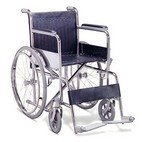Greed, Engineering Stupidity? - Your Call...
A day after having my Quantum 6000's joystick controller replaced, I'm still fuming that the diagnosis of my chair's power issue was incorrect and that I was stuck with a $921.00 bill for a component that was well used but entirely functional.
The new $921.00 joystick control unit,
My previous tech informed me that the Permobil control unit was built in China. I imagine the Quantum is also a Chinese product. Why China? Well, for one reason alone - to save money for the manufacturer; not the client!
I suspect that the unit costs in the neighbourhood of $10.00 to mass produce and I'm probably overestimating. Three film pressure switches; a row of LED lights; the gimbal joystick and a few chips and microprocessors within housing of recycled plastic. Tack on the cost of shipping in overseas containers (literally a slow boat from China) and mark the product up 100%. Stockholders and investors will be pleased. The CEO can buy another Mercedes.
I can purchase an audiophile quality stereo component for about the same price as my joystick controller --- and it has a significantly greater number of electronic chips, components and circuitry than does the joystick. Market size for these exotic components are probably smaller as well --- a poor excuse.
How can the cost be justified when many of the disabled relying on these products are destitute, unemployed, have no private insurance coverage and no huge wrongful injury settlement. Well, the government will pay --- so jack up the price. Remember it is not the government, but the taxpayer that pays and that means most of us.
So after they misdiagnosed my power issue, I was told I needed a new motor to replace the damaged one (the one which measured "bang-on" company specs a month ago)
The problem is that the small round housing holding one of the motor's brushes is cracked. But you cannot replace the brush --- individual motor brushes are not marketed so you have to replace the whole motor.
'Can you imagine having to replace your car engine because you need new spark plugs?'
As I lamented in my previous post --- can you imagine needing a new spark-plug for your car and you're told the only way to get a new spark-plug is to install a new engine!
Technicians tell me that the motors are not repaired but are scrapped. Crushed, ground up and melted to recover the metals.
A throw-away society that congratulates itself on being environmentally green! Yeah, I'll light a candle for that during Earth Hour!
The engineering geniuses also designed motors that are not reversible; left can not be swapped for right or vice-versa. Why? As I understand it, they are attached to a frame or housing which only fits one side. Twice the needed inventory space makes no sense. (more on that further below).
The Dual Quantum motors are indicated by the red arrows. The also point to the lever which engages or disengages the motor from the wheelchair (so it can be manually pushed). Simply flipping the motor over to the opposite side would put the leaver facing inward. Can the black cap on the rear of the motor be unscrewed and flipped around to make the motor interchangeable? Can a left motor be mounted in the right motor's housing? I never received a clear answer from my tech. I suspect it is not that easy,
When the motor(s) failed on my Permobil, they specifically ordered a left (or right) motor. Is it different for the Quantum?
My issues are not with the Quantum chair, nor Pride which is the parent company. This Quantum was given to me free of charge by a sympathetic friend and the chair was old with worn parts that would last an unknown duration. It is well past its life expectancy but I wish to keep it going for heavy use outside around the garden and garage.
My final gripe is that nobody stocks parts any longer because of the cost of storage of a variety of parts that may or may not at some time be needed. Very little is kept at the shop. Everything seems to be ordered by carrier pigeon and shipped by that 'slow boat from China'. No faxing orders --- no overnight courier shipping. The client can wait --- they're disabled and have no life anyway.
You can't sell what you don't stock! Unfortunately, with Shopper's Home Healthcare out of the wheelchair business (though they were incompetent), there is no alternative to turn to and therefore no competition, Companies competing for clients would keep each other on their toes and serve their clients better.
Am I bitter? Hell yes! The franchise in this city is not run as efficiently as the previous one of the same name in my previous town. Now that Shopper's Home Healthcare has divested itself of wheelchairs they are the only game in town. There is no competition. Service lags, long wait times for service and technicians are stressed. It's a formula for disaster.
This chair will no longer climb my ramp and I was advised not to "push it" as it may fail altogether before replacement motors are available.
2018 may be the summer I spend indoors.
* * *







.jpg)










